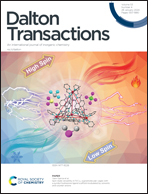Effects of solvatomorphism, the nature of a chelating ligand synthon and a counterion on the single crystal XRD structure and SMM properties of paramagnetic monocapped cobalt(ii) tris-pyrazoloximates†
Abstract
A series of monocapped cobalt(II) tris-pyrazoloximates was obtained through the template condensation of the corresponding pyrazoloxime, phenylboronic acid and a suitable cobalt(II) halogenide. Comparing 3-acetylpyrazoloxime versus its methine-containing homolog, the former produced cobalt(II) clathrochelates in substantially higher yields due to the electron donating effect of the methyl substituent, increasing the N-donor ability of its oxime group. Their less N-donor analog with the electron acceptor trifluoromethyl group did not form cobalt(II) complexes of this type. In all their solvent-free and solvent-containing crystals, the encapsulated cobalt(II) ion adopted a high-spin state, as gauged by the Co–N bond lengths of 2.112(4)–2.188(9) Å, and was located almost in the center of its CoN6-coordination polyhedron. Their CoN6-polyhedra had an almost ideal trigonal-prismatic (TP) geometry with distortion angles φ below 4°. This TP-like geometry was assisted by hydrogen bonding between their NH groups and the apical counterion. The absence of methyl groups makes them close to an ideal TP. In contrast, stronger N–H⋯Cl hydrogen bonds occurred in the methyl-containing complex, while the Co–N bond lengths stayed the same at 2.144(2) Å on average. In its solvates with benzene, chloroform and acetone, there is a clear tendency for φ to decrease from 2.7(3)° to 0.47(13)°. The comparable effects of the ribbed methyl substituents, the cross-linking counterion and the lattice solvent on their molecular geometry were observed; the larger the distortions from an ideal TP geometry, the stronger the hydrogen bonds to the corresponding apical halogenide anion. The analysis of the experimental AC- and DC-magnetometry data for their fine-crystalline samples suggests that the passing from the derivative of the methyl-substituted synthon to that of its methine-containing homolog caused a substantial decrease in the magnetic susceptibility value χT and an increase in the QTM contribution to the magnetic relaxation. The effect of a cross-linking halogenide counteranion on the Orbach remagnetization barrier is greater than that of the solvatomorphism of their crystals.



 Please wait while we load your content...
Please wait while we load your content...